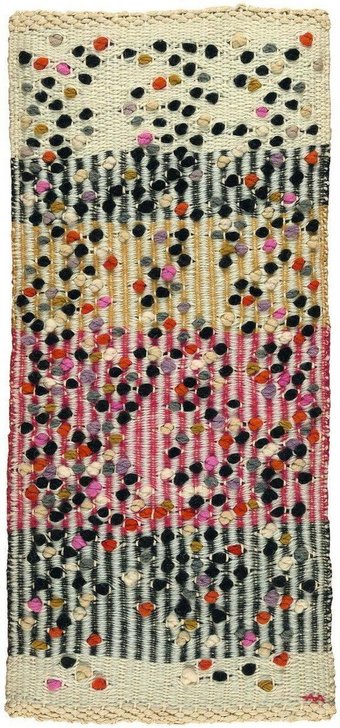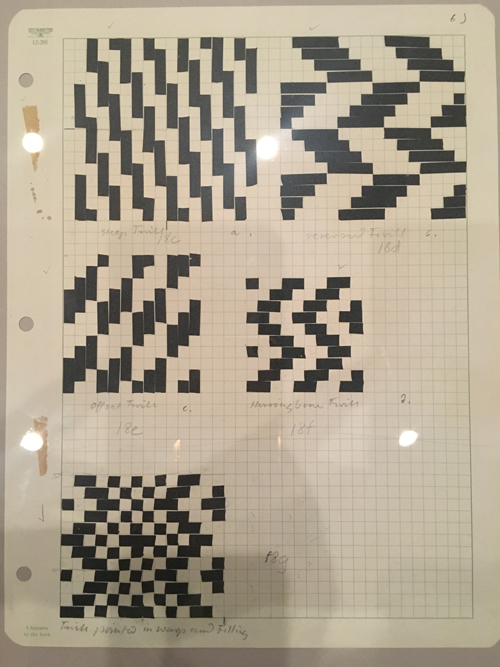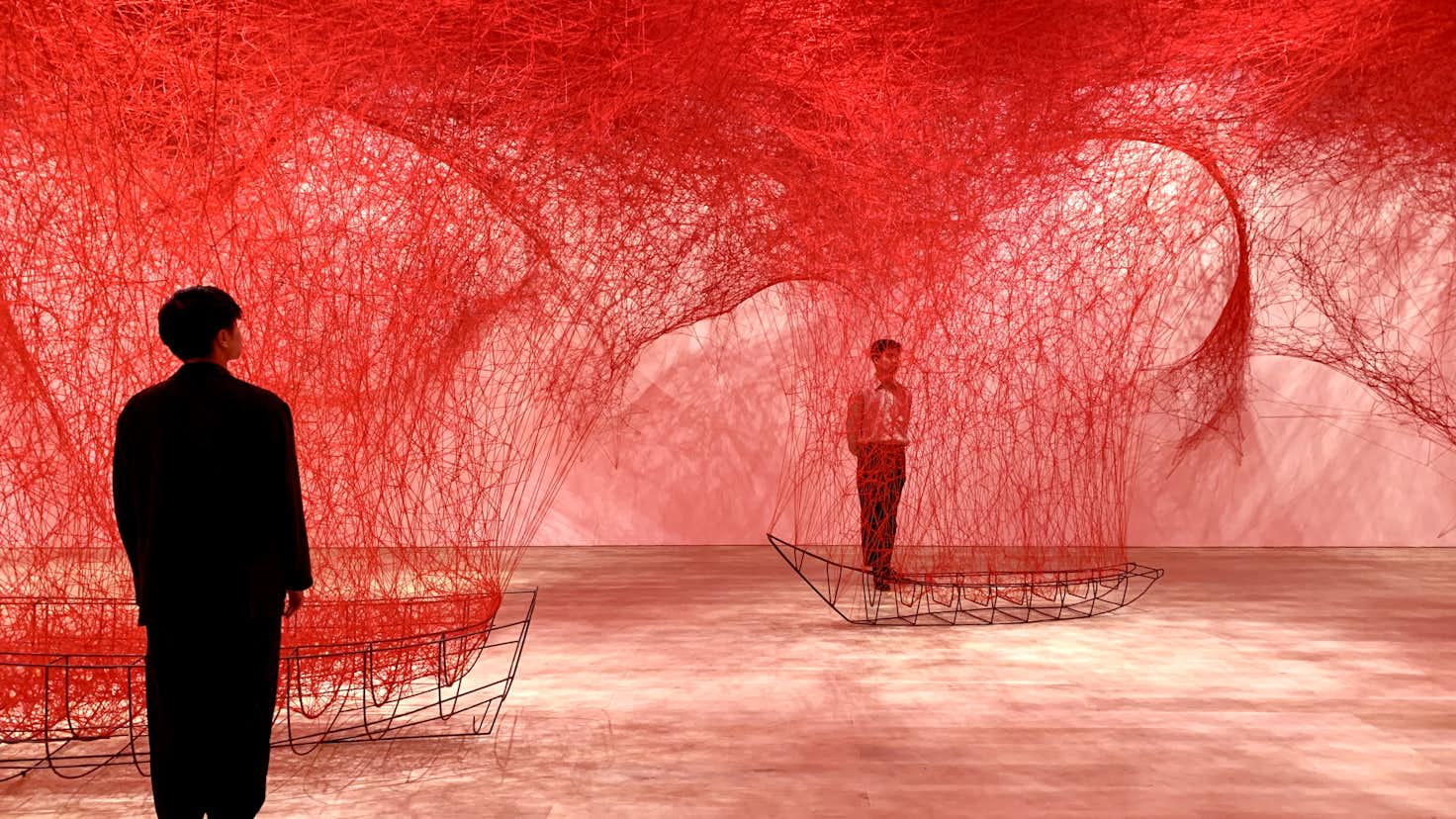Anni Albers
Bio
Born in Berlin at the turn of the 20th century, Anni Albers was not only a weaver, but also an inspiring artist, designer, teacher and author. Her life and work took her from Berlin to Weimar and Dessau, where she was a vital member of the textile workshop at the Bauhaus. In 1933, together with her husband, the painter Josef Albers, she escaped Nazi Germany and moved to the United States, where both became influential teachers at Black Mountain College in North Carolina, a school that would become celebrated for its experimental, interdisciplinary approach. From 1950 until her death in 1994, Anni lived near New Haven in rural Connecticut, weaving (until the late 1960s), travelling, teaching and writing well into old age.
About the Artist (National Museum of Women in the Arts)
Anni Albers, the most influential 20th-century textile designer, fearlessly experimented and blurred traditional boundaries between art and craft. Akin to her distinctive “pictorial weavings,” Albers interwove her talents as an artist, designer, writer, and teacher to compose a richly textured 60-year career. After periods of creatively stifling training under Impressionist painter Martin Brandenburg, who forbade Albers from using the color black, and at the School of Applied Arts, where she tired of designing floral wallpaper, Albers attended the pioneering Bauhaus. The Bauhaus enrolled Albers in the only workshop open to female students—weaving. Albers considered textiles “too sissy, like needlepoint and the other things . . . ladies do,” but grew to embrace the medium and created “pliable planes” of richly colored, complex abstract compositions. Albers combined natural and synthetic fibers and incorporated non-traditional materials into her work. While attending the Bauhaus, the artist met painters Josef Albers (whom she married in 1925), Wassily Kandinsky, and Paul Klee. In 1933, the Albers couple moved to North Carolina to escape the Nazi regime and teach at Black Mountain College. Albers taught there until 1949, the year she became the first weaver to have a solo exhibition at the Museum of Modern Art in New York (MoMA). In 1963, after “endless years spent at the loom,” Albers took up lithography and screen printing, further exploring the interplay between dynamic patterns and bold color combinations. Albers’s impact on the art and design world remains intact.
Quotes
“We must find our way back to simplicity of conception in order to find ourselves. For only by simplicity can we experience meaning, and only by experiencing meaning can we become qualified for independent comprehension.” ~ Anni Albers, Color Field, 2016
“The conscientious designer, does not himself design at all but rather give the object-to-be a chance to design itself.” Anni Albers, 1958. From the Tate website, also linked below.
“All progress, so it seems, is coupled to regression elsewhere. We have advanced in general, for instance, in regard to verbal articulation — the reading and writing public of today is enormous. But we have grown certainly increasingly insensitive to our perception of touch — the tactile sense.” Anni Albers, 1965. From the Tate article
https://www.theguardian.com/artanddesign/2018/oct/10/bauhaus-josef-anni-albers-art
##
Lectures
- Designing as Visual Organization (Sound)
Lecture at Yale University ca. 1958 https://albersfoundation.org/teaching/anni-albers/lectures/#tab1
- On Weaving
https://albersfoundation.org/teaching/anni-albers/lectures/#tab3
Articles
https://www.1843magazine.com/culture/look-closer/weaving-anni-albers-back-into-art-history
https://www.artsy.net/article/artsy-editorial-anni-albers-artist
https://www.tate.org.uk/whats-on/tate-modern/exhibition/anni-albers/seven-life-hacks-anni-albers
https://www.artsy.net/article/artsy-editorial-women-weavers-bauhaus-inspired-generations-textile-artists
https://www.dezeen.com/2018/11/13/anni-albers-exhibition-tate-modern-bauhaus-weaving-design/
On her approach to teaching https://albersfoundation.org/teaching/anni-albers/introduction/
Work
https://albersfoundation.org/art/anni-albers/weavings/index/ https://albersfoundation.org/art/anni-albers/drawings/index/





|  |


Untitled I Silkscreen on paper 26 x 20 inches (sheet size); 24 1/8 x 18 3/4 inches (image size) 1963 http://thejohnsoncollection.org/anni-albers-untitled-1/
https://www.pinterest.com/jljklv13/anni-albers/
https://www.pinterest.com/jljklv13/anni-albers/
https://www.guggenheim-bilbao.eus/en/learn/schools/teachers-guides/code-1962
http://kvadratinterwoven.com/typewriters-and-tactile-textiles
On Weaving PDF https://arena-attachments.s3.amazonaws.com/5632047/50d35356dc7797f6bbb8b04224c64721.pdf?1575320318
Notebook Sketches











Museum Tour
https://www.youtube.com/watch?v=J1HlZfORTJo&
https://www.davidzwirner.com/exhibitions/anni-albers-2019
collection of Anni Albers’s works from Moma.
https://www.moma.org/artists/96#works
https://davidzwirnerbooks.com/product/anni-albers-notebook-19701980
recorded lecture on Zoom by Fritz Horstman about Anni Albers’s significant contributions to art and design (48 mins) https://theglasshouse.org/whats-on/fritz-horstman-on-anni-albers/
Videos
https://www.youtube.com/watch?v=pXd1e4vekZI&
Bridget Riley

Quotes & Articles
“Perception is the Medium,” Bridget Riley, ARTNews 1965
“To begin with, I have never studied “optics” and my use of mathematics is rudimentary and confined to such things as equalizing, halving, quartering and simple progressions. My work has developed on the basis of empirical analyses and syntheses, and I have always believed that perception is the medium through which states of being are directly experienced”
“Focusing isn’t just an optical activity, it is also a mental one.”
https://www.davidzwirner.com/exhibitions/bridget-riley/-/media/DavidZwirner/Exhibitions/2015/bridget%20riley/bridget-riley-david-zwirner-2015_checklist.pdf ^ Exhibition checklist from Zwirner retrospective in 2015
Riley quotes from Paul Klee’s The Thinking Eye (translated 1961), which she cites as ‘one of my bibles in the 1960s’, continuing: ‘This particular paragraph struck a very powerful chord: “My freedom thus consists in my moving about within the narrow frame that I have assigned myself for each one of my undertakings. I shall go even further: my freedom will be so much the greater and more meaningful, the more narrowly I limit my field of action and the more I surround myself with obstacles. Whatever diminishes constraint diminishes strength. The more constraints one imposes, the more one frees oneself of the chains that shackle the spirit.” I think that’s a very beautiful piece, and it became a guiding principle.’ Gombrich responds with a quotation from a sonnet by Goethe, which concludes: ‘Accepting limits will reveal the master, and nothing but the law can give us freedom.’ https://frieze.com/article/seeing-believing-1
Smiling, Riley insists that “Nature is much better than anything I can do.” https://www.ft.com/content/aac6af02-deb4-11e8-b173-ebef6ab1374a
Works

|  |


Bridget Riley videos
Series of videos from an exhibition at Southbank Centre (2019-20)
https://www.youtube.com/watch?v=8E4WNwiAeNE&
https://www.youtube.com/watch?v=NT72ie-i1zw&
https://www.youtube.com/watch?v=XR2yTmNOKJ0&
https://www.youtube.com/watch?v=sko99rW7Nbs&
https://www.youtube.com/watch?v=fPxz0hC_4_k&
Related artists
Chiharu Shiota (塩田千春)
https://www.chiharu-shiota.com/top-japanese

Ruth Asawa
“Techniques are simple to learn. Making them something that represents you will take a lifetime.”



Samantha Bittman
https://www.artsy.net/artist/samantha-bittman
Quilts of Gee’s Bend

https://www.soulsgrowndeep.org/gees-bend-quiltmakers
Beryl Korot
https://www.moma.org/collection/works/191231
Janine Antoni
http://www.janineantoni.net/slumber
Rafael Rozendaal
https://www.newrafael.com/abstract-browsing-weavings/
ODILI
https://nasher.duke.edu/exhibitions/odili-donald-odita-murals/
OTHER: Stephen Monteiro’s Fabric of Interface Introduction
https://www.dropbox.com/s/ipjg7w1xmzk0tvc/The_Fabric_of_Interface_Mobile_Media_Des.pdf?dl=0
Weaving and Code
https://www.openprocessing.org/sketch/89249/
https://boingboing.net/2018/01/17/how-to-code-like-a-weaver.html
Color Palette tools (taken from chat)
https://programmingdesignsystems.com/color/color-schemes/index.html
Hind Al Saad To Everyone12:14:49 AM
https://kgolid.github.io/chromotome-site/
https://github.com/kgolid/chromotome
david stein To Everyone12:15:13 AM
I have used this site to create a palette from photos. It is amazing how a photo of nature or the real world creates such pleasing palettes: https://coolors.co/image-picker
